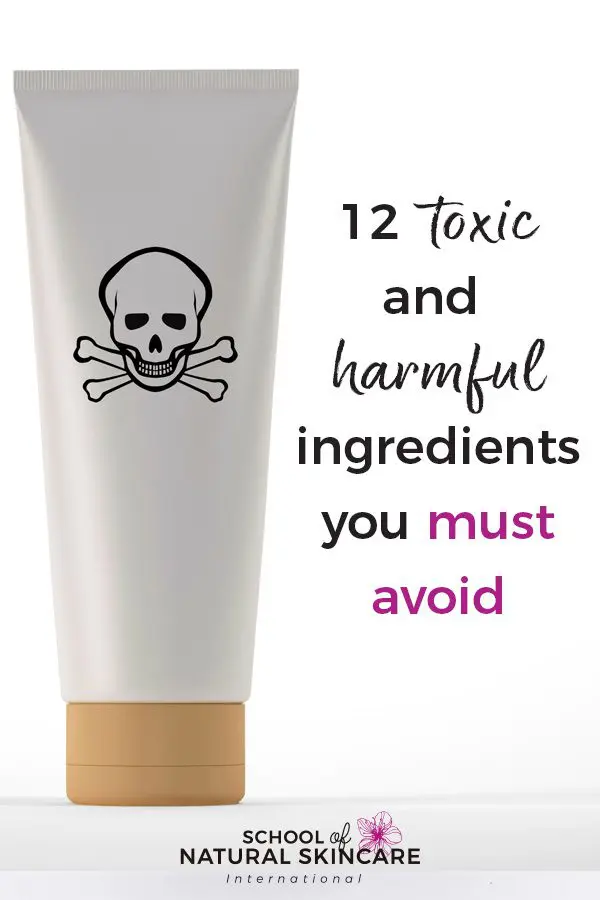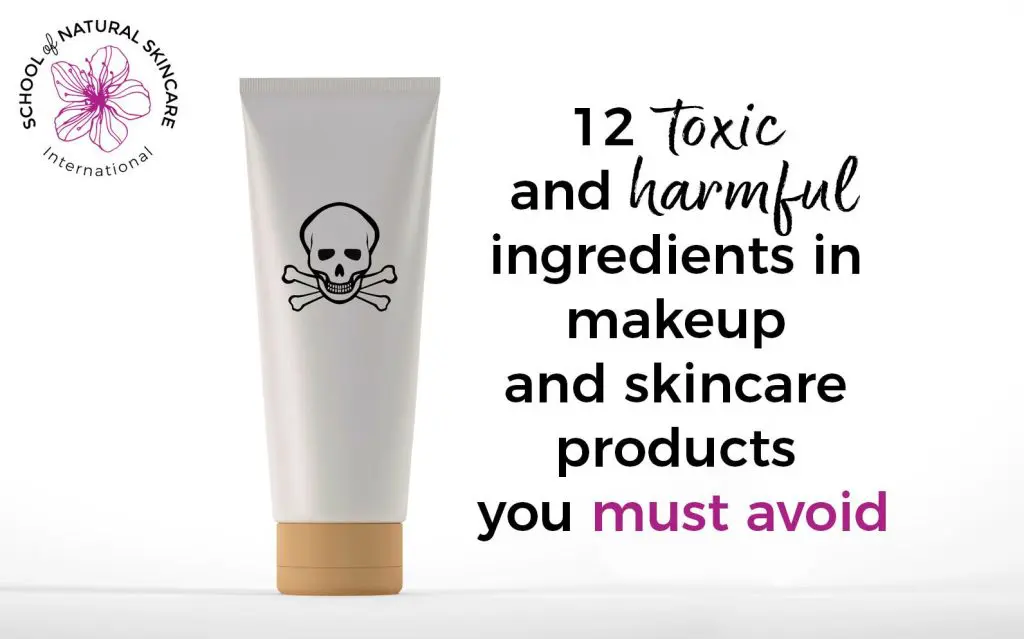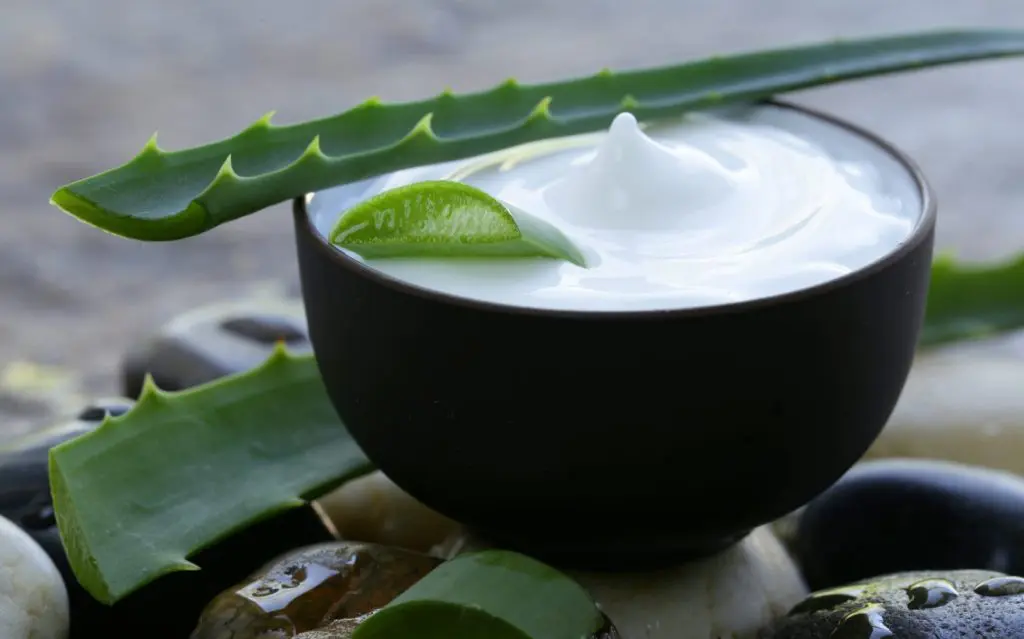With so many harmful ingredients in makeup and skincare products we asked our resident Cosmetic Chemist, Chandni Patel, to compile this in-depth guide, backed up by scientific studies to help you know what to avoid.
Ready? Let’s get started!
The skin is the largest organ of the body. It has several functions, the most important being to form a physical barrier to the environment, allowing and limiting the inward and outward passage of water, electrolytes and various substances while providing protection against microorganisms, ultraviolet radiation and toxic agents (Washington education, 2006).
However, the skin’s porous nature means what you put on it can penetrate through the superficial layer of the skin, which in turn can affect your health and sense of well-being, negatively or positively.
This article will focus on 12 key ingredients found in skincare and/or makeup products that can have a negative impact your health and sense of well-being, and that should be avoided.
Let’s look at each of these in more detail now.
1) Phthalates
Phthalates (also called phthalic acid esters) are multifunctional chemicals. There have been concerns over phthalates’ exposure to the body due to their detection in blood, amniotic fluid and human breast milk across many countries (Koniecki et al, 2011).
Currently, all phthalates have been banned from cosmetics in the European Union under category two substances (which may be considered as impairing fertility) (Koniecki et al, 2011) however, some countries such as USA still employ phthalates in cosmetics and skincare products.
2) Parabens
Parabens are a family of synthetic esters of p-hydroxybenzoic acid that share similar molecular structures and are widely used as preservatives.
Paraben compounds; the most common being methylparaben, propylparaben, and butylparaben have been found to affect oestrogen levels, potentially impacting female reproductive health (Gao et al, 2016).
This is further supported by a new study by Geer et al (2016), which found an association between antimicrobials and adverse birth outcomes in neonates. These findings are also consistent with animal data resulting in developmental and reproductive toxicity.
3) Triclosan
Triclosan is a wide-spectrum antimicrobial agent. It is believed that Triclosan can penetrate through the skin and it is a suspected endocrine disruptor, that is, it affects hormone function. This is supported by a 2009 study which found that triclosan decreased thyroid hormone concentrations.
In addition, another study showed that triclosan enhanced the expression of androgen and oestrogen-sensitive genes (Zorilla et al, 2008, Ahn et al 2008).
Furthermore, Triclosans lipophilic nature has shown accumulation in fatty tissues, which has been supported by studies that found concentrations of triclosan in three out of five human milk samples (Adolfsson-Erici et al, 2002, Allymr et al, 2006)
4) Sodium lauryl sulphate (SLS)
Sodium lauryl sulphate was introduced globally more than 60 years ago as an emulsifier or detergent. This surfactants is used as the primary detergent in a many products such as skin cleansers, shampoos and shower gels.
Studies on skin irritation of surfactants show that irritation is dependent on the structure of the sulphate. SLS is an anionic detergent which tends to be more irritating to the skin and eyes in comparison to amphoteric and non-ionic detergents (L. Rhein, 2007).
Their ability to remove stratum corneum lipids means they penetrate the skin deeper into the viable layers and cause immune reactions (Lémery et al, 2015).
In addition, they are also known to elicit skin reactions such as irritant contact dermatitis or may cause inflammation. Though emulsions are often used to treat inflammatory skin disorders such as eczema, emulsions may also cause skin disorders because of the presence of surfactants added as stabilisers (Bárány et al, 2000).
5) Polyethylene glycols (PEGs)
Polyethylene glycols are petroleum-based ingredients and are often used in creams in particular, as a moisturizing agent.
They have a penetration-enhancing effect, which is important to remember for several reasons:
Firstly, PEGs make it easier for other undesirable ingredients in your skincare products to penetrate deep into your skin.
Secondly, PEGs have the potential to disrupt the skin’s natural moisture balance, thus altering the surface tension of the skin.
And thirdly, PEGs often come contaminated with toxic impurities. Examples of these impurities are ethylene oxide and 1,4-dioxane. Studies have shown exposure to high concentrations of 1,4-dioxane may cause eye, skin, and respiratory irritation, nervous system effects, and liver and kidney toxicity (Stickney and Carlson-Lynch, 2014).
Although ethylene oxide has exhibited a low carcinogenic potency in animal models, epidemiological studies have not conclusively linked exposures to ethylene oxide with carcinogenic outcomes in humans (Parod, 2014). Information on PEG toxicity is limited and contradictory, but they should be avoided to ensure safety.
6) Imidazolidinyl urea
Imidazolidinyl urea is often found in water-based cosmetics. It serves as a preservative or additive in these types of products and after application often remains on the skin for hours, allowing sufficient time to be absorbed by the skin’s dermal cells.
Its formaldehyde-releasing ability makes it a potential allergen and toxicant in humans. Formaldehyde in cosmetics is widely understood to cause allergic skin reactions and rashes in some people (Flyvholm MA and Menne T, 1992; Boyvat A, 2005; Prat et al 2004).
Other formaldehyde-releasing chemicals to look out for are DMDM hydantoin, diazolidinyl urea, methenamine, and quarternium-15.
7) Triethanolamine (TEA)
Triethanolamine (TEA) is primarily used as a pH adjuster and it also has several other purposes in cosmetic and personal care products, for example, a surfactant, buffering and masking agent.
TEA is an amine produced by reacting ethylene oxide (considered highly toxic) with ammonia (another known toxin). These compounds break down over time and recombine to form nitrosamines which can be carcinogenic and toxic.
It has been determined by CIR (Cosmetic Ingredient Review Assessments) as a skin toxicant and “safe for use in cosmetics and personal care products designed for discontinuous, brief use followed by thorough rinsing from the surface of the skin. In products intended for prolonged contact with the skin, the concentration of Triethanolamine should not exceed 5%.”
8) Sunscreen chemicals
Sunscreen chemicals such as benzophenone-3, ethylhexyl methoxycinnamate (EHMC) and butyl methoxydibenzoylmethane, (BMDBM) have more recently been utilised in cosmetic and personal care products to protect consumers against the adverse effects of solar radiation.
However, some UV filters can have side effects with potential health risks to the consumer.
Laboratory studies of several sunscreen chemicals indicate that they may mimic hormones and disrupt the hormone system (Krause et al 2012; Schlumpf 2001, 2008).
In addition, two European studies have detected sunscreen chemicals in mothers’ breast milk, indicating that the developing fetus and newborns may be exposed to these substances (Schlumpf 2008; Schlumpf 2010). A 2010 study by Margaret Schlumpf of the University of Zurich found at least one sunscreen chemical in 85 percent of milk samples.
Mineral sunscreens such as zinc oxide and titanium dioxide are usually better in terms of safety, however, it is important the forms used are coated with inert chemicals as to reduce photoactivity otherwise the user could potentially suffer damage to their skin.
9) Synthetic colorants
Synthetic colorants are often incorporated in cosmetics and hair dyes to make them look ‘pretty’, however, the FD&C colors* used in these product types are derived from coal tar (a byproduct of petroleum). Some of these are restricted by the FDA, (Food and Drugs Administration) in the USA, to 10 parts per million of lead and arsenic due to their carcinogenic nature.
A study by Jiang et al found women who used permanent hair dye once a month for more than a year double their risk of bladder cancer (Jiang et al, 2001).
In addition, Lake** colors can also be derived from coal tar and stimulate allergic reactions.
(* In the United States, FD&C numbers [which indicate that the FDA has approved the colorant for use in foods, drugs and cosmetics] are given to approved synthetic food dyes that do not exist in nature.
** A lake pigment is a pigment manufactured by precipitating a dye with an inert binder, or “mordant”, usually a metallic salt.)
10) Synthetic fragrances
Synthetic fragrances are used in some cosmetic products and primarily personal care products. However, they are not required to be declared in the ingredients list other than indicated under ‘parfum’, therefore it is impossible to know which fragrance substances are in the cosmetic products we purchase. This has raised some concerns as there have been some reported side-effects of these substances related to skin sensitivity, rashes, dermatitis, coughing, asthma attacks, migraine, etc (De Groot and Frosch, 1997, Bickers, et al., 2003).
Some of the ingredients of concern and their potential effects can be further read-up on the following link www.safecosmetics.org/get-the-facts/chemicals-of-concern/fragrance/
11) Polyacrylamides
Polyacrylamides are used in color cosmetics, skincare lotions and moisturizers as stabilizing and binding agents or foaming, anti-static, and lubricating agents. Though the ingredient itself is not a concern, its potential to break down into acrylamide, which is a suspected carcinogenic, is concerning.
This has been supported by human studies who have found associations between acrylamide exposure and pancreatic cancer among men, exposed in the workplace. Moreover, studies have shown that acrylamide may reduce fetal weight at doses in the low parts per million ranges (Manson et al, 2005).
As a consequence of the potential negative effects, the use of acrylamide is banned in cosmetics in the EU and the EU also sets limits on the amount of residual acrylamide allowed in products containing polyacrylamide.
12) Hydroquinone
Hydroquinone is used primarily in skincare products as a whitening agent. This ingredient has been related to several health concerns, cancer and organ-system toxicity. Studies which support these concerns have shown hydroquinone works by decreasing the production and increasing the degradation of melanin pigments in the skin. This increases the skin’s exposure to UVA and UVB rays, increasing the risk of skin cancer (Jimbow et al, 1974). Also, hydroquinone has been linked to a skin condition called Ochronosis in which the skin thickens and turns bluish-grey (Findlay et al, 1975).
What to do next?
There are a few ways you can be sure you are avoiding these toxic ingredients.
The first is to get really good at reading product labels. Try not to be blinded by beautifully packaged, scientifically substantiated claims, on-trend colours and gorgeous scents when selecting your make-up and skincare products, and to pay careful attention to the ingredients present in these products, before you purchase them. Even then you may find some products not labelled correctly (yes, it happens).
The other is to make your own products. That way you can be 100% sure about what is going into them.
If you are ready to gain control over what you are putting on your skin, our Certificate in Making Natural Skincare Products is for you!

Liked learning about these ingredients? Save this image below on Pinterest so you can be sure to remember!

References:
- http://courses.washington.edu/bioen327/Labs/Lit_SkinStruct_Bensouillah_Ch01.pdf
- Diane Koniecki, Rong Wang, Richard P. Moody, Jiping Zhu, 2011, Phthalates in cosmetic and personal care products: Concentrations and possible dermal exposure, Environmental Research, 111(3) 329-336.
- Yanpeng Gao, Yuemeng Ji, Guiying Li, Taicheng An,, 2016, Theoretical investigation on the kinetics and mechanisms of hydroxyl radical-induced transformation of parabens and its consequences for toxicity: Influence of alkyl-chain length, Water Research, (91) 77-85.
- Laura A. Geer, Benny F.G. Pycke, Joshua Waxenbaum, David M. Sherer, Ovadia Abulafia, Rolf U. Halden, 2016, Association of Birth Outcomes with Fetal Exposure to Parabens, Triclosan and Triclocarban in an Immigrant Population in Brooklyn, New York.
- Zorrilla L, Gibson EK, Jeffay SC, Crofton KM, Setzer Wr, Cooper RL, and Stoker TE, 2008, “The effects of Triclosan on Puberty and Thyroid Hormones in Male Wistar Rats,” Toxicological Sciences, 107(1) 56-64.
- Ahn KC, Zhao B, Chen J, Cherednichenko G, Sanmarti E, Denison MS, Lasley B, Pessah IN, Kültz D, Chang DP, Gee SJ, Hammock BD, 2008, “In vitro biologic activities of the antimicrobials triclocarban, its analogs, and triclosan in bioassay screens: receptor-based bioassay screens.” Environ Health Perspect, 116(9):1203-10.
- Adolfsson-Erici M, Pettersson M, Parkkonen J, and Sturve J, 2002, “Triclosan, a commonly used bactericide found in human milk and in the aquatic environment in Sweden.” Chemosphere, 46(9-10):1485-9.
- Allymr M, Adolfsson-Erici M, McLachlan MS, and Sandborgh-Englund G, 2006, “Triclosan in plasma and milk from Swedish nursing mothers and their exposure via personal care products.” Sci Total Environ. 372(1):87-93.
- L. Rhein, 2007, C.3 – Surfactant Action on Skin and Hair: Cleansing and Skin Reactivity Mechanisms
- Emmanuelle Lémery, Stéphanie Briançon, Yves Chevalier, Claire Bordes, Thierry Oddos, Annie Gohier, Marie-Alexandrine Bolzinger, March 2015, Skin toxicity of surfactants: Structure/toxicity relationships, 469:166-179.
- E. Bárány, M. Lindberg, M. Lodén, 2000, Unexpected skin barrier influence from nonionic emulsifiers, Int. J. Pharm., 195 (2000):189–195.
- J. Stickney, H. Carlson-Lynch, 2014, Dioxane, 1,4-Reference Module in Biomedical Sciences, from Encyclopaedia of Toxicology (Third Edition), Pages 186-189.
- R.J. Parod, September 2014, (Reference Module in Biomedical Sciences, from Encyclopaedia of Toxicology (Third Edition), Pages 535-538.
- Flyvholm MA, Menne T, 1992, Allergic contact dermatitis from formaldehyde. A case study focusing on sources of formaldehyde exposure. Contact Dermatitis, 27(1):27-36.Boyvat A, Akyol A, Gurgey E, 2005, Contact sensitivity to preservatives in Turkey. Contact Dermatitis, 52(6):333-337.
- Pratt MD, Belsito DV, DeLeo VA, Fowler JF Jr, Fransway AF, Maibach HI, Marks JG, Mathias CG, Rietschel RL, Sasseville D, Sheretz EF, Storss FJ, Taylor JS, Zug K, 2004, North American Contact Dermatitis Group patch-test results, 2001-2002 study period. Dermatitis, 27(1):27-36
- Krause M, Klit A, Blomberg Jensen M, Søeborg T, Frederiksen H, Schlumpf M, Lichtensteiger W, Skakkebaek NE, Drzewiecki KT, 2012, Sunscreens: are they beneficial for health? An overview of endocrine disrupting properties of UV-filters, International Journal of Andrology. 35(3):424-36
- Schlumpf M, Cotton B, Conscience M, Haller V, Steinmann B, Lichtensteiger W, 2001, In vitro and in vivo estrogenicity of UV screens, Environ Health Perspect. 109(3):239-44.
- Schlumpf M, Durrer S, Faass O, Ehnes C, Fuetsch M, Gaille C, Henseler M, Hofkamp L, Maerkel K, Reolon S, Timms B, Tresguerres JA, Lichtensteiger W, 2008, Developmental toxicity of UV filters and environmental exposure: a review, Int J Androl, 31(2):144-51.
- Schlumpf M, Kypke K, Wittassek M, Angerer J, Mascher H, Mascher D, Vökt C, Birchler M, Lichtensteiger W, 2010, Exposure patterns of UV filters, fragrances, parabens, phthalates, organochlor pesticides, PBDEs, and PCBs in human milk: correlation of UV filters with use of cosmetics. Chemosphere, (10):1171-83.
- X Jiang, J E Castelao, S Groshen, V K Cortessis, D Shibata, D V Conti, J-M Yuan, M C Pike, and M Gago-Dominguez, 2001, Urinary tract infections and reduced risk of bladder cancer in Los AngelesDe Groot AC, Frosch PJ, 1997, Adverse reactions to fragrances. A clinical review, Contact Dermatitis., 36(2):57-86.
- David R Bickers, Peter Calow, Helmut A Greim, Jon M Hanifin, Adrianne E Rogers, Jean-Hilaire Saurat, I Glenn Sipes, Robert L Smith, Hachiro Tagami, 2003, The safety assessment of fragrance materials, Regulatory Toxicology and Pharmacology 37 (2):218–273.
- http://www.safecosmetics.org/get-the-facts/chemicals-of-concern/fragrance/
- Jeanne Manson, Michael J. Brabec, Judy Buelke-Sam, Gary P. Carlson, Robert E. Chapin, John B. Favor, Lawrence J. Fischer, Dale Hattis, Peter S.J. Lees, Sally Perreault-Darney, Joe Rutledge, Thomas J. Smith, Raymond R. Tice and Peter Working, 2005, NTP‐CERHR Expert Panel report on the reproductive and developmental toxicity of acrylamide. Birth Defects Research Part B: Developmental and Reproductive Toxicology, 74(1): 17-113.
- Jimbow, K., Obata, H., Pathak, M. A. and Fitzpatrick, T. B., 1974, Mechanisms of depigmentation by hydroquinone. Journal of Investigative Dermatology 62: 436–449.
- Findlay, G. H., Morrison, J. G. L., & Simson, I. W, 1975, Exogenous ochronosis and pigmented colloid milium from hydroquinone bleaching creams, British Journal of Dermatology, 93(6):613-622.




